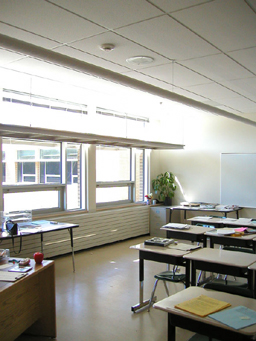 |
|
|
 |
|
|
|
|
|
| Abstract: |
 |
|
| The intent of this case study is to evaluate the lighting system at Ash Creek Intermediate School in Monmouth, Oregon. The building was designed by BOORA architects (Portland), with daylighting consulting by the Seattle Lighting Lab. After our initial visit to the school we felt that the lighting in the classrooms was slightly uneven. To test our hypothesis: “The integrated lighting system at Ash Creek Intermediate does not provide even lighting throughout the classroom,” our team measured the illuminance from all sources (daylight and electric) in a south-facing classroom. We took these measurements on a sunny day as well as on an overcast day in the winter of 2003. In addition to measurements of the overall illuminance, our team took measurements from each of four individual light sources in order to ascertain which source provided the highest level of illuminance. We found that the illuminance was indeed uneven, though much less so on a sunny day. While the electric lights are the greatest single source of illumination, the daylighting, on a sunny day, easily matches the strength of the electric lights. Our study examines the viability of daylight to provide adequate and even lighting, and Ash Creek is an excellent example of several technologies that are remarkably successful. |
|
 |
|
 |
|
 |
|
 |
|
 |
|
|
Photo Courtesy of Seattle Lighting Lab |
|
|
 |
|
|
|
|
| Introduction: |
|
|
Daylighting design is a complex issue involving many variables. A designer must consider fenestration size, orientation, shading, and judge how these variables might affect a given space. The designer must provide adequate and even ambient light levels, reduce glare and successfully integrate the daylighting and electric lighting system in a way that reduces electrical costs, while keeping heating costs in check. These design issues are especially evident in schools. It is well accepted that natural light can affect mood and mental health, and that lighting levels greatly influence a person’s ability to perform a visual task. There has been great discussion whether natural light can affect a student’s performance. With this increased interest in daylighting in schools, architects are continually investigating daylighting methods. While there are many tools available to architects wishing to test their daylighting models during the design process such as computer simulation and scale models. However, the best way to test a design is through Post Occupancy Evaluation. This case study evaluates a daylighting system in a recently constructed building. Is the dayligting successful? What determines a design’s success? What improvements could be made on the system? These are all questions we seek to answer.
|
|
 |
|
 |
|
 |
|
|
|
|
|
|
|
|
|
|
|
|










